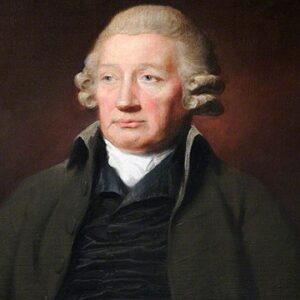John Wilkinson was a British businessman who pioneered the production of cast iron and discovered new uses for it during the ‘Industrial Revolution.’ John was an intellectual child with a creative mind who was exposed to iron-furnace labor at a young age, having been born in England to a part-time ironworker and inventor. He became a partner in the iron business with his father after finishing his early education and relocated to Staffordshire, where he erected Bilston’s first iron furnace. He built numerous more blast furnaces and created ironworks after that, before inheriting his father’s ironworks in Bersham and forming the New Bersham Company. Bersham soon became the world leader in iron technology, and John was dubbed “The Great Staffordshire Ironmaster.” Later, he built a boring machine that was crucial to James Watt’s steam engine’s success, allowing him to bore engine cylinders and cannon barrels with unrivaled precision. He also had an impact on cannon design, inventing the cannon-boring machine that resulted in safer and more accurate cannons. He was a driving force behind the construction of the world’s first cast-iron arch bridge, as well as the launch of the world’s first iron barge. He was a renowned ironmaster and an 18th-century industrialist who built his wealth selling high-quality iron items. Wilkinson, John “Iron-Mad”
Childhood and Adolescence
Isaac Wilkinson, an ironworker and inventor, and his wife, Mary Johnson, gave birth to John Wilkinson in Little Clifton, Bridgefoot, Cumberland, England in 1728. He had a half-brother named William, who was 17 years his junior.
John was born into a non-conformist Presbyterian family and had his early education at a Kendal academy run by Dr. Caleb Rotherham, a dissenting English preacher, and teacher.
John served a five-year apprenticeship under a Liverpool merchant in 1745. He later joined his father in the iron business as a partner.
The Career of John
In 1755, John Wilkinson formed a partnership with the Bersham Ironworks, and two years later, he and his associates built a blast furnace in Willey, Shropshire. He was therefore able to construct another furnace at New Willey.
He patented a hydraulic-powered blast furnace blowing engine in 1757.
He also developed ironworks in Snedshill, Hollinswood, Hadley, and Hampton Loade, among other places. He also leased property in Bilston parish to develop another at Bradley Works.
John became renowned as the Father of the huge South Staffordshire iron industry, with Bilston as the beginnings of the Black Country, which became one of the most industrialized sections of Britain throughout the Industrial Revolution.
Bersham Ironworks was taken over by him in 1761. He became the owner of his own furnace in 1763 and quickly established himself as a renowned supplier of castings and weaponry.
In 1774, he patented the design of his first boring machine, which was designed exclusively for the production of cannons. The machine was a success in boring engine cylinders to James Watt’s strict standards because of its robust design, which facilitated precise cutting.
He was the driving force behind the construction of the Iron Bridge, which connected Broseley to the other side of the River Severn, in 1775. It was the world’s first cast-iron arch bridge when it opened in 1781.
He later purchased ownership in eight Cornish copper mines and formed a partnership with Thomas Williams, the ‘Copper King’ of Anglesey’s Parys Mountain mines. The Cornish Metal Corporation was founded by the two in 1785 as a copper marketing company with warehouses in Birmingham, London, Bristol, and Liverpool.
John also purchased lead mines in a number of locations and installed steam pumping engines to bring them back into production. He exported the majority of the lead produced and utilized part of it at his lead pipe plant in Rotherhithe, London.
In 1792, he purchased the Brymbo Hall estate in Denbighshire, where he erected further furnaces. In Broseley, he also became a churchwarden, and in 1799, he was named High Sheriff of Denbighshire.
John’s Major Projects
He achieved revolutionary advances in the production of cast iron and the usage of cast iron goods, which greatly aided the Industrial Revolution. He developed a precision boring machine capable of drilling cast-iron cylinders and designed a blast furnace blowing technology that allowed for greater temperatures and hence increased efficiency.
Personal History and Legacy
John Wilkinson married Ann Maudsley, a wealthy family’s daughter, whose dowry assisted John in obtaining a share in the New Willey Company. They didn’t have any children.
Following Ann’s death, he married Mary Lee, whose wealth enabled John to gain control of his company by buying out his partners. The couple didn’t have any children.
Mary Ann Lewis, John’s mistress, gave birth to his three children, a boy, and two girls, while he was in his 70s.
On July 14, 1808, at his works at Bradley, Staffordshire, England, John Wilkinson died. At his Castlehead estate in Lindale, he was first interred in a cast-iron coffin of his own design. His body was transferred multiple times throughout the years and is now vanished.
His Philanthropic Contributions
He was a generous person who constructed cottages for his staff wherever he set up shop. He made iron troughs for schools that didn’t have slates to contain sand for writing and arithmetic exercises, as well as a cast-iron pulpit for a church in Bilston.
Estimated Net worth
Jonny Wilkinson has a net worth of $21 million as an English rugby union player. Jonny Wilkinson was born in Frimley, Surrey, England on May 25, 1979.
At the Newcastle School of Rugby, he began his career as an inside center. During the 1997-98 season, he helped the Falcons win the Allied Dunbar Premiership.


